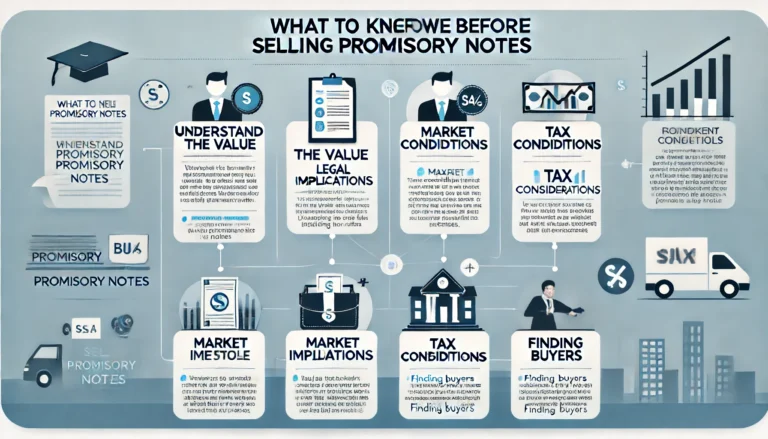How to Buy and Sell Promissory Notes: A Comprehensive Guide
Investing in promissory notes can be a lucrative addition to your portfolio, offering a balance between risk and reward that many investors find appealing. However, understanding how to buy and sell promissory notes requires a careful approach and knowledge of both the market and legal landscape. In this guide, we’ll break down the essentials to help you navigate this unique investment opportunity with confidence.
What Are Promissory Notes?
Before diving into the specifics of buying and selling promissory notes, it’s crucial to understand what they are. A promissory note is a financial instrument that represents a written promise by one party (the issuer or maker) to pay a specific sum of money to another party (the payee or holder) either on-demand or at a set future date. These notes are essentially formalized IOUs and are often used in business transactions and personal lending.
Key Components of Promissory Notes
Promissory notes typically include:
- The principal amount: The sum of money being borrowed.
- The interest rate: The cost of borrowing, usually expressed as an annual percentage.
- The maturity date: When the note must be repaid.
- The payment terms: How and when payments are to be made.
- Any collateral securing the note: Assets pledged by the borrower to protect the lender.
How to Buy Promissory Notes
Understanding the Market
When considering how to buy promissory notes, it’s important to recognize that they can be purchased on the secondary market or directly from the issuer. Here’s how each method works:
- Secondary Market: This is where previously issued promissory notes are bought and sold. Think of it like buying a used car rather than a brand-new one. These notes can be found through brokers, online marketplaces, or private sales. Prices here can vary based on factors like the note’s remaining term, the creditworthiness of the issuer, and current interest rates.
- Direct Purchase: In this case, you buy the note directly from the issuer. This could be a company seeking to raise funds or an individual looking to secure a loan. These transactions often occur in private settings and can be tailored to specific needs and terms.
Evaluating Promissory Notes
To make a sound investment, evaluate the following before buying promissory notes:
- Issuer’s Creditworthiness: Investigate the financial health and credit history of the borrower. Higher credit risk might mean higher returns but also a greater chance of default.
- Interest Rate: Compare the offered rate with prevailing market rates to ensure you’re getting a fair return for the risk you’re taking.
- Collateral: Determine if the note is secured or unsecured. Secured notes offer more protection but might come with lower interest rates.
- Legal Considerations: Ensure the note is legally binding and compliant with relevant laws and regulations. This often requires the assistance of a financial advisor or attorney.
The Buying Process
To buy a promissory note, follow these steps:
- Find a Note: Use brokers, marketplaces, or your network to locate promissory notes for sale.
- Perform Due Diligence: Thoroughly review the note’s terms and the issuer’s financial status.
- Negotiate Terms: Discuss and agree on the purchase price and any modifications to the original terms.
- Execute the Purchase: Complete the transaction, ensuring all legal documents are correctly signed and recorded.
How to Sell Promissory Notes
Why Sell Promissory Notes?
You might consider selling promissory notes for several reasons:
- To liquidate an asset quickly for cash.
- To diversify your investment portfolio.
- To reduce exposure to potential risk.
Preparing to Sell
Before putting a promissory note on the market, take these steps to maximize its value:
- Update Documentation: Ensure all paperwork is current and complete. This includes payment histories, copies of the note, and any amendments.
- Assess Market Conditions: Evaluate the current demand for promissory notes and economic conditions that might affect their value.
- Set a Competitive Price: Price your note based on factors such as the remaining term, interest rate, and the creditworthiness of the issuer.
The Selling Process
To sell a promissory note, follow these steps:
- Market the Note: List the note with brokers or on online platforms, or reach out to potential buyers directly.
- Negotiate Offers: Review offers and negotiate terms with potential buyers. Be prepared to provide detailed information about the note and the issuer.
- Due Diligence by Buyer: Allow the buyer to conduct their due diligence. This might include reviewing the issuer’s financial status and the note’s payment history.
- Finalize the Sale: Complete the transaction, ensuring all legal and financial documents are properly handled and transferred.
Risks and Rewards of Promissory Notes
Investing in promissory notes carries both risks and rewards. Understanding these can help you make informed decisions.
Potential Rewards
- Regular Income: Promissory notes typically provide regular interest payments, offering a steady income stream.
- Higher Yields: Compared to other fixed-income investments, promissory notes can offer higher returns, especially if you’re willing to accept more risk.
- Portfolio Diversification: Adding promissory notes to your investment mix can help diversify your portfolio and reduce overall risk.
Possible Risks
- Default Risk: The borrower might fail to make payments, leading to potential losses. This is why assessing the issuer’s creditworthiness is critical.
- Interest Rate Risk: Rising interest rates can reduce the market value of existing notes, as new notes may offer higher returns.
- Liquidity Risk: Selling a promissory note before its maturity might be challenging, and you could receive less than its face value.
Tips for Success
When buying and selling promissory notes, it’s essential to consider the following SEO strategies to ensure your content reaches the right audience:
To excel in the world of promissory notes, it’s vital to stay informed and updated. Understanding the nuances of how to buy and sell promissory notes will not only enhance your financial acumen but also position you as a savvy investor in this niche market. As you explore the opportunities, keep in mind the critical aspects of due diligence, market analysis, and legal compliance. These steps will guide you in making well-informed decisions, ensuring that your ventures into promissory notes are both profitable and secure. Whether you’re a seasoned investor or a newcomer to this field, mastering the art of buying and selling promissory notes can open doors to new financial horizons.
Key SEO Strategies
- Keyword Usage: Integrate keywords like how to buy and sell promissory notes naturally into your content, including headings and subheadings.
- Internal and External Links: Provide links to related content on your site and authoritative external sources to improve SEO and user experience.
- Engaging Meta Descriptions: Craft compelling meta descriptions that include your primary keywords to attract more clicks from search results.
- Content Structure: Use headings, bullet points, and short paragraphs to make your content easy to read and digest.
Conclusion
Buying and selling promissory notes can be a rewarding endeavor, offering a blend of stability and higher returns. By understanding the market, performing thorough due diligence, and following a structured buying and selling process, you can maximize the potential of this unique investment. Always stay informed and seek professional advice when needed to navigate the complexities of the promissory note market effectively.
For more insights into investing in promissory notes and other financial instruments, visit Simanda Investments. Our team of experts is here to guide you through every step of your investment journey, ensuring you make informed and profitable decisions.
4o





